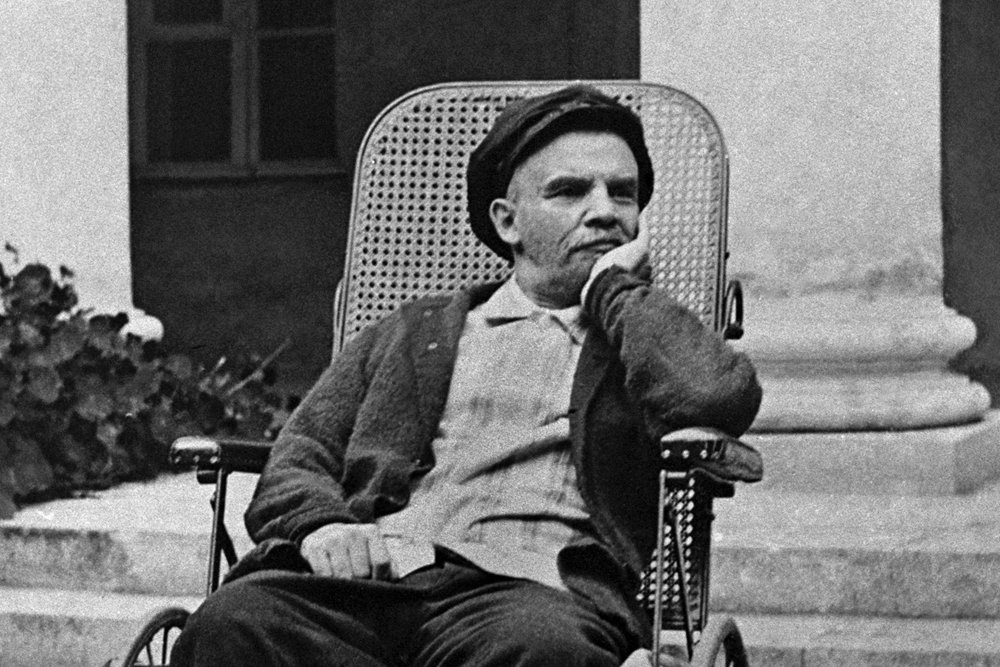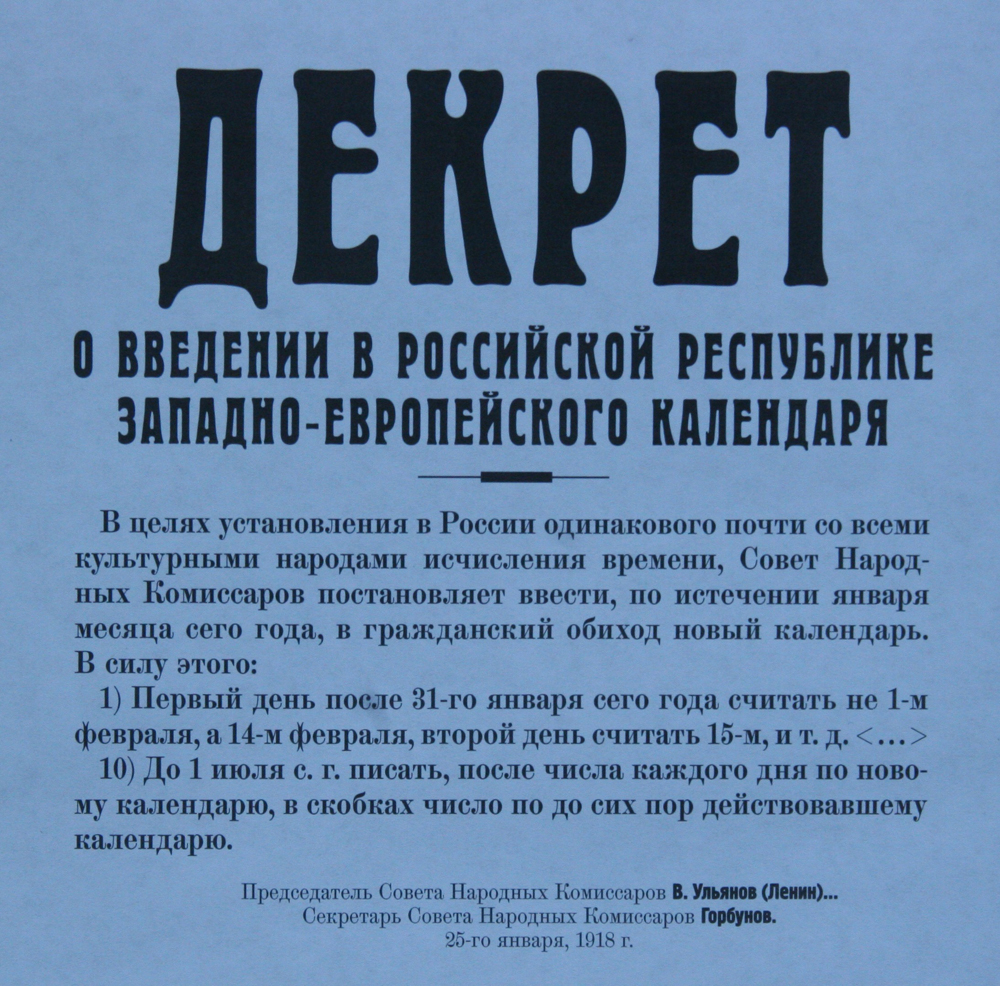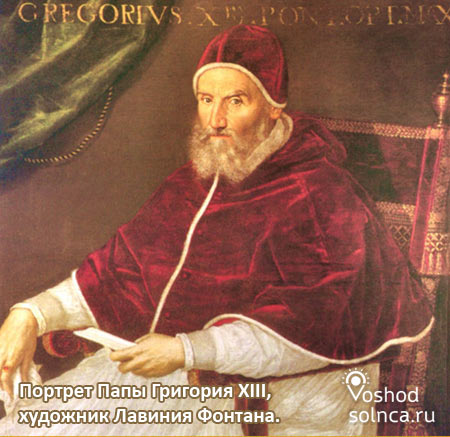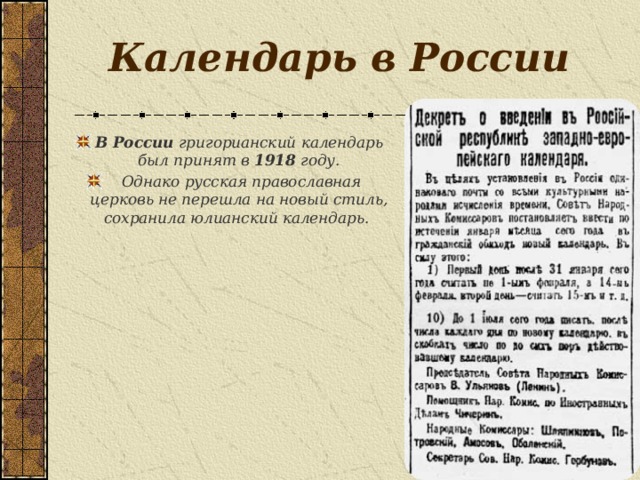Switching to the Gregorian calendar. Time systems
Citizens of the Soviet country, having gone to bed on January 31, 1918, woke up on February 14. The "Decree on the introduction of the Western European calendar in the Russian Republic" came into force. Bolshevik Russia switched to the so-called new, or civil, style of calculating time, which coincided with the church Gregorian calendar used in Europe. These changes did not affect our Church: she continued to celebrate her holidays according to the old, Julian calendar.

The calendar split between Western and Eastern Christians (believers began to celebrate the main holidays in different time) occurred in the 16th century, when Pope Gregory XIII undertook another reform that replaced the Julian style with the Gregorian one. The purpose of the reform was to correct the growing difference between the astronomical year and the calendar year.
Obsessed with the idea of world revolution and internationalism, the Bolsheviks, of course, did not care about the Pope and his calendar. As stated in the decree, the transition to the Western, Gregorian style was made "in order to establish in Russia the same time calculation with almost all cultural peoples" .... At one of the first meetings of the young Soviet government in early 1918, two draft reforms of time were considered "The first proposed a gradual transition to the Gregorian calendar, each year dropping 24 hours. This would take 13 years. The second provided for doing it in one fell swoop. It was he who liked the leader of the world proletariat Vladimir Ilyich Lenin, who surpassed the current ideologist of multiculturalism Angela Merkel in globalist projects.
Competently
Religious historian Alexei Yudin on how Christian churches celebrate Christmas:
First, let's make it clear right away: to say that someone celebrates on December 25, and someone on January 7 is incorrect. Everyone celebrates Christmas on the 25th, but according to different calendars. In the next hundred years, from my point of view, no unification of the celebration of Christmas is to be expected.
Old Julian calendar, adopted under Julius Caesar, lagged behind astronomical time. The reform of Pope Gregory XIII, which from the very beginning was called papist, was perceived extremely negatively in Europe, especially in Protestant countries, where the reformation was already firmly established. The Protestants were opposed primarily because "it was conceived in Rome." And this city in the XVI century was no longer the center of Christian Europe.

Red Army soldiers take out church property from the Simonov Monastery on a subbotnik (1925). A photo: wikipedia.org
The reform of the calendar, if desired, can, of course, be called a split, bearing in mind that the Christian world has already split not only along the East-West principle, but also within the West.
That's why Gregorian calendar was perceived as Roman, papist, and therefore unsuitable. Gradually, however, the Protestant countries accepted it, but the process of transition took centuries. This is how things were in the West. The East paid no attention to the reform of Pope Gregory XIII.
The Soviet Republic switched to new style, but this, unfortunately, was connected with the revolutionary events in Russia, the Bolsheviks, of course, did not think about any Pope Gregory XIII, they simply considered the new style to be the most adequate to their worldview. And the Russian Orthodox Church has an additional trauma.
In 1923, at the initiative of the Patriarch of Constantinople, a meeting of Orthodox churches was held, at which a decision was made to correct the Julian calendar.
Representatives of the Russian Orthodox Church, of course, were unable to travel abroad. But Patriarch Tikhon nevertheless issued a decree on the transition to the "New Julian" calendar. However, this caused protests among believers, and the decision was quickly canceled.
You can see that there were several stages of searching for a match on a calendar basis. But this did not lead to the final result. So far, this issue has not been included in a serious church discussion at all.
Is the Church afraid of another schism? Undoubtedly, some ultra-conservative groups within the Church will say: "The sacred time has been betrayed." Any Church is a very conservative institution, especially when it comes to everyday life and liturgical practices. And they rest against the calendar. And the church-administrative resource in such matters is ineffective.
Every Christmas, the theme of switching to the Gregorian calendar pops up. But this is politics, profitable media presentation, PR, whatever you want. The Church itself does not participate in this and is reluctant to comment on these issues.
Why does the Russian Orthodox Church use the Julian calendar?
Father Vladimir (Vigilyansky), rector of the Church of the Holy Martyr Tatiana at Moscow State University:
Orthodox churches can be roughly divided into three categories: those that serve all church holidays according to the new (Gregorian) calendar, those that serve only according to the old (Julian) calendar, and those that mix styles: for example, in Greece, Easter is celebrated according to old calendar, and all other holidays - in a new way. Our churches (Russian, Georgian, Jerusalem, Serbian and Athos monasteries) never changed the church calendar and did not mix it with the Gregorian, so that there would be no confusion in the holidays. We have a single calendar system, which is tied to Easter. If we switch to celebrating, say, Christmas according to the Gregorian calendar, then two weeks are “eaten up” (remember how February 14 came after January 31 in 1918), each day of which carries a special semantic significance for an Orthodox person.
The church lives according to its own order, and in it many significant things may not coincide with secular priorities. For example, in church life there is a clear system of progression of time, which is tied to the Gospel. Every day, excerpts from this book are read, in which there is a logic associated with the gospel story and the earthly life of Jesus Christ. All this lays down a certain spiritual rhythm in the life of an Orthodox person. And those who use this calendar do not want and will not violate it.
A believer has a very ascetic life. The world can change, we see how before our very eyes fellow citizens have a lot of opportunities, for example, for recreation during the secular New Year holidays. But the Church, as one of our rock singers sang, "will not bend under the changing world." We will not make our church life dependent on the ski resort.

The Bolsheviks introduced new calendar"for the purpose of calculating the time identical with almost all cultural peoples." A photo: Publishing project of Vladimir Lisin "Days of 1917 100 years ago"
Since 46 BC, the Julian calendar has been used in most countries of the world. However, in 1582, by decision of Pope Gregory XIII, it was replaced by the Gregorian. In that year, the day after the fourth of October was not the fifth, but the fifteenth of October. Now the Gregorian calendar is officially adopted in all countries except Thailand and Ethiopia.
Reasons for adopting the Gregorian calendar
The main reason for introducing new system chronology was the movement of the day of the vernal equinox, depending on which the date of the celebration of Christian Easter was determined. Due to discrepancies between the Julian and the tropical calendar (the tropical year is the length of time during which the sun completes one cycle of the seasons), the day of the vernal equinox gradually shifted to ever earlier dates. At the time of the introduction of the Julian calendar, it fell on March 21, both according to the accepted calendar system and in fact. But to XVI century, the difference between the tropical and Julian calendars was already about ten days. As a result, the day of the spring equinox was no longer on March 21, but on March 11.

Scientists drew attention to the above problem long before the adoption Gregorian system chronology. Back in the 14th century, Nikephoros Gregoras, a Byzantine scholar, reported this to Emperor Andronicus II. According to Grigora, it was necessary to revise the calendar system that existed at that time, because otherwise the date of the celebration of Easter would continue to shift to an ever later time. However, the emperor did not take any action to eliminate this problem, fearing a protest from the church.
In the future, other scientists from Byzantium spoke about the need to switch to a new calendar system. But the calendar continued to remain unchanged. And not only because of the fear of the rulers to cause indignation among the clergy, but also because the further the Christian Easter was pushed back, the less chance it had to coincide with the Jewish Easter. This was unacceptable according to church canons.
By the 16th century, the problem had become so urgent that the need to solve it was no longer in doubt. As a result, Pope Gregory XIII assembled a commission, which was instructed to carry out all the necessary research and create a new calendar system. The results obtained were displayed in the bull "Among the most important". It was she who became the document with which the adoption of the new calendar system began.
The main disadvantage of the Julian calendar is its lack of accuracy in relation to the tropical calendar. In the Julian calendar, leap years are all years that are divisible by 100 without a remainder. As a result, every year the difference with the tropical calendar increases. Approximately every one and a half centuries, it increases by 1 day.

The Gregorian calendar is much more accurate. It has fewer leap years. Leap years in this system of chronology are years that:
- divisible by 400 without a remainder;
- divisible by 4 without a remainder, but not divisible by 100 without a remainder.
Thus, 1100 or 1700 in the Julian calendar are considered leap years because they are divisible by 4 without a remainder. In the Gregorian calendar, of the past, after its adoption, 1600 and 2000 are considered leap years.
Immediately after the introduction of the new system, it was possible to eliminate the difference between the tropical and calendar years, which at that time was already 10 days. Otherwise, due to errors in the calculations, an extra year would run every 128 years. In the Gregorian calendar, an extra day only occurs every 10,000 years.

Far from all modern states, the new chronology system was adopted immediately. The Catholic states were the first to switch to it. In these countries, the Gregorian calendar was officially adopted either in 1582 or shortly after the decree of Pope Gregory XIII.
In a number of states, the transition to a new calendar system was associated with popular unrest. The most serious of them took place in Riga. They lasted for five whole years - from 1584 to 1589.
There were also some funny situations. So, for example, in Holland and Belgium, due to the official adoption of the new calendar, after December 21, 1582, January 1, 1583 came. As a result, the inhabitants of these countries were left without Christmas in 1582.
Russia adopted the Gregorian calendar one of the last. The new system was officially introduced on the territory of the RSFSR on January 26, 1918 by a decree of the Council of People's Commissars. In accordance with this document, immediately after January 31 of that year, February 14 came on the territory of the state.
Later than in Russia, the Gregorian calendar was introduced only in a few countries, including Greece, Turkey and China.
![]()
After the official adoption of the new chronology system, Pope Gregory XIII sent a proposal to Constantinople to switch to a new calendar. However, she was met with a refusal. Its main reason was the inconsistency of the calendar with the canons of the celebration of Easter. However, in the future, most Orthodox churches still switched to the Gregorian calendar.
To date, only four Orthodox churches use the Julian calendar: Russian, Serbian, Georgian and Jerusalem.
Date rules
In accordance with the generally accepted rule, dates that fell between 1582 and the moment the Gregorian calendar was adopted in the country are indicated both in the old and in the new style. In this case, the new style is indicated in quotation marks. Earlier dates are given in accordance with the proleptic calendar (i.e., the calendar used to indicate dates earlier than the date the calendar appeared). In countries where the Julian calendar was adopted, dates prior to 46 B.C. e. are indicated according to the proleptic Julian calendar, and where it was not - according to the proleptic Gregorian.
Different peoples, religious cults, astronomers tried to make the calculation of the inexorably current time both the most accurate and simple for any person. The starting point was the movement of the Sun, Moon, Earth, the location of the stars. There are dozens of calendars developed and used so far. For the Christian world, there were only two significant calendars used for centuries - Julian and Gregorian. The latter is still the basis of the chronology, which is considered the most accurate, not subject to the accumulation of errors. The transition to the Gregorian calendar in Russia occurred in 1918. With what it was connected, this article will tell.
From Caesar to the present day
The Julian calendar was named after this multifaceted personality. The date of its appearance is considered to be January 1, 45. BC e. by decree of the emperor. It's funny that the starting point has little to do with astronomy - this is the day the consuls of Rome take office. This calendar, however, was not born from scratch:
- It was based on the calendar ancient egypt, which has existed for centuries, in which there were exactly 365 days, the change of seasons.
- The second source for compiling the Julian calendar was the existing Roman one, where there was a division into months.
It turned out to be a fairly balanced, thoughtful way of visualizing the passage of time. It harmoniously combined ease of use, clear periods with astronomical correlation between the Sun, Moon and stars, known for a long time and influencing the movement of the Earth.
The appearance of the Gregorian calendar, completely tied to the solar or tropical year, is due to grateful humanity to Pope Gregory XIII, who indicated that all Catholic countries should switch to a new time on October 4, 1582. It must be said that even in Europe this process was neither shaky nor rough. So, Prussia switched to it in 1610, Denmark, Norway, Iceland - in 1700, Great Britain with all overseas colonies - only in 1752.
When did Russia switch to the Gregorian calendar?
Thirsty for everything new after everything was destroyed, the fiery Bolsheviks gladly gave the command to switch to a new progressive calendar. The transition to it in Russia took place on January 31 (February 14), 1918. The Soviet government had quite revolutionary reasons for this event:
- Almost all European countries have long since switched to this method of reckoning, and only the reactionary tsarist government suppressed the initiative of peasants and workers who were very prone to astronomy and other exact sciences.
- The Russian Orthodox Church was against such violent intervention, which violated the sequence of biblical events. And how can "sellers of dope for the people" be smarter than the proletariat armed with the most advanced ideas.
Moreover, the differences between the two calendars cannot be called fundamentally different. By and large, the Gregorian calendar is a modified version of the Julian. The changes are mainly aimed at eliminating, less accumulation of temporary errors. But as a result of the dates of historical events that happened long ago, the births of famous personalities have a double, confusing reckoning.

For example, the October Revolution in Russia happened on October 25, 1917 - according to the Julian calendar or according to the so-called old style, which is historical fact or November 7 of the same year in a new way - Gregorian. It feels like the Bolsheviks carried out the October uprising twice - the second time for an encore.
The Russian Orthodox Church, which the Bolsheviks were not able to force to recognize the new calendar either by executions of clergy or by organized robbery of artistic values, did not deviate from the biblical canons, counting the passage of time, the offensive church holidays according to the Julian calendar.
Therefore, the transition to the Gregorian calendar in Russia is not so much a scientific, organizational event as a political one, which at one time affected the fate of many people, and its echoes are still heard today. However, against the backdrop of a fun game of "turn the time forward / backward by an hour", which is still not completely over, judging by the initiatives of the most active deputies, this is already just a historical event.
God created the world outside of time, the change of day and night, the seasons allows people to put their time in order. To do this, humanity invented a calendar, a system for calculating the days of the year. The main reason for switching to another calendar was the disagreement about the celebration big day for Christians - Easter.
Julian calendar
Once upon a time, during the reign of Julius Caesar, in 45 BC. The Julian calendar appeared. The calendar itself was named after the ruler. It was the astronomers of Julius Caesar who created the system of chronology, focused on the time of successive passage of the equinox point by the Sun. , so the Julian calendar was a "solar" calendar.
This system was the most accurate for those times, each year, not counting leap years, contained 365 days. In addition, the Julian calendar did not contradict the astronomical discoveries of those years. For fifteen hundred years, no one could offer this system a worthy analogy.
Gregorian calendar
However, at the end of the XIV century, Pope Gregory XIII proposed a different system of chronology. What was the difference between the Julian and the Gregorian calendar, if there was a difference in the number of days for them? A leap year was no longer considered every fourth year by default, as in the Julian calendar. According to the Gregorian calendar, if a year ended in 00 but was not divisible by 4, it was not a leap year. So 2000 was a leap year, and 2100 will no longer be a leap year.
Pope Gregory XIII was based on the fact that Easter should be celebrated only on Sunday, and according to the Julian calendar, Easter each time fell on different days weeks. February 24, 1582 the world learned about the Gregorian calendar.
Popes Sixtus IV and Clement VII also advocated reform. The work on the calendar, among others, was led by the Jesuit Order.
Julian and Gregorian calendars - which is more popular?
The Julian and Gregorian calendars continued to exist together, but in most countries of the world it is the Gregorian calendar that is used, and the Julian calendar remains for calculating Christian holidays.
Russia was among the last to adopt the reform. In 1917, immediately after the October Revolution, the “obscurantist” calendar was replaced by a “progressive” one. In 1923, they tried to transfer the Russian Orthodox Church to the “new style”, but even with pressure on His Holiness Patriarch Tikhon, a categorical refusal followed from the Church. Orthodox Christians, guided by the instructions of the apostles, calculate holidays according to the Julian calendar. Catholics and Protestants consider holidays according to the Gregorian calendar.
The issue of calendars is also a theological issue. Despite the fact that Pope Gregory XIII considered the astronomical rather than the religious aspect to be the main issue, later arguments appeared about the correctness of this or that calendar in relation to the Bible. In Orthodoxy, it is believed that the Gregorian calendar violates the sequence of events in the Bible and leads to canonical violations: the Apostolic canons do not allow the celebration of holy Pascha before Jewish Pascha. The transition to a new calendar would mean the destruction of Paschalia. Scientist-astronomer Professor E.A. Predtechensky in his work "Church time: reckoning and critical review existing rules definitions of Easter" noted: “This collective work (Editor’s note – paschalia), in all likelihood by many unknown authors, was made in such a way that it still remains unsurpassed. The later Roman Paschalia, now adopted by the Western Church, is, in comparison with the Alexandrian, so heavy and clumsy that it resembles a popular print next to an artistic representation of the same subject. For all that, this terribly complex and clumsy machine still does not achieve its intended goal.. In addition, the descent of the Holy Fire at the Holy Sepulcher takes place on Holy Saturday according to the Julian calendar.
Different ways of reckoning the calendar. A new style of counting time was introduced by the Council of People's Commissars - the government Soviet Russia January 24, 1918 "Decree on the introduction of the Western European calendar in the Russian Republic".
The decree was intended to promote “the establishment in Russia of the same time calculation with almost all cultural peoples”. After all, since 1582, when throughout Europe the Julian calendar was replaced by the Gregorian calendar in accordance with the recommendations of astronomers, the Russian calendar turned out to be 13 days different from the calendars of civilized states.
The fact is that the new European calendar was born through the efforts of the Pope, but the Catholic Pope was not an authority or decree for the Russian Orthodox clergy, and they rejected the innovation. So they lived for more than 300 years: in Europe New Year,in Russia on December 19th.
The new style of the calendar began its countdown in Russia on February 1, 1918.
Decree of the Council of People's Commissars (an abbreviation of the Council of People's Commissars) dated 01/24/1918 prescribed February 1, 1918 to be considered February 14 (in parentheses, we note that, according to long-term observations, Russian orthodox calendar, that is " old style”, more consistent with the climate of the European part Russian Federation. For example, on March 1, when according to the old style it is still deep February, there is no smell of spring, and relative warming begins from mid-March or its first days according to the old style).
Not everyone liked the new style
However, not only Russia rested on the establishment of a Catholic count of days, in Greece the "New Style" was legalized in 1924, Turkey - 1926, Egypt - 1928. At the same time, something is not heard that the Greeks or Egyptians celebrated, as in Russia, two holidays: the New Year and the Old New Year, that is, the New Year according to the old style.
It is interesting that the introduction of the Gregorian calendar was accepted without enthusiasm even in those European countries where the leading religion was Protestantism. So in England they switched to a new account of time only in 1752, in Sweden - a year later, in 1753.
Julian calendar
It was introduced by Julius Caesar in 46 BC. Started January 1st. The year had 365 days. The number of the year divisible by 4 was recognized as a leap year. One day was added to it - February 29. The difference between the calendar of Julius Caesar and the calendar of Pope Gregory is that the former has a leap year every fourth without exception, while the latter has leap years only those years that are divisible by four, but not multiples of a hundred. As a result, the difference between the Julian and Gregorian calendars is gradually increasing and, for example, in 2101 Orthodox Christmas will be celebrated not on January 7, but on January 8.






